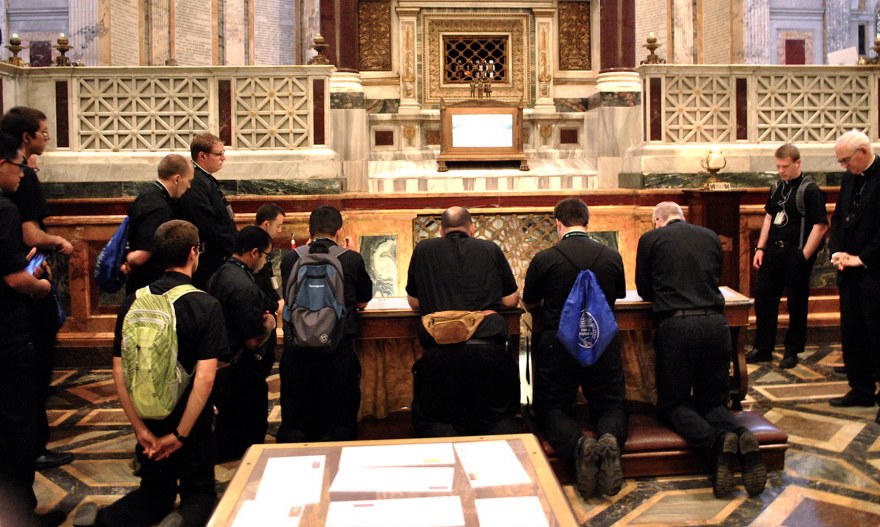“Top Five” 2015: Week Three
by Bill Fox (Diocese of Kansas City-St. Joseph)
Top Five Highlights of Week Three:
So we are concluding Week 3 of The Rome Experience. Week 3 is the week with the most scheduled group events for the whole program. Being asked to identify this week’s “Top Five,” this is good news for your humble writer, as there are so many events to choose from. The bad news is that all these events were so impactful that trying to narrow them down to five, much less rank them, requires exclusion of activities that, were it not for the other experiences we have had, would have been reasons alone to come to Rome. Your humble writer, however, will do his best.
Number Five: The Basilica of Saint Paul Outside-the-Wall. We could not have asked for a better tour guide. We were shown the basilica by the basilica’s archpriest himself, James Cardinal Harvey. As St. Peter’s Basilica was built over the remains of St. Peter, so St. Paul Outside-the-Wall was built over the remains of St. Paul. The original structure stood from the 4th Century to the middle of the 19th Century where it was destroyed by a tremendous fire. The basilica was immediately rebuilt. It features frescos, on the top of the walls, each in turn, of all the popes. Cardinal Harvey suggested that given how much more simple St. Paul’s is compared to the other three major basilicas (the aforementioned St. Peters, St. Mary Major and the Mother of all the Churches, St. John Lateran), and the fact that it’s, “off the beaten track”, comparatively speaking, that it was an easier space to pray in. Yet, St. Paul’s has its own points of particular attention. St. Paul’s remains are directly under the altar, after all, and in the confessio, the space directly in front of the main altar and several steps down, we were able to pray in front of the sarcophagus in which St. Paul’s remains were originally interred as well as the chains that kept him bound while he was under house arrest in the last weeks of his life on earth. We also saw an additional episcopal throne for the Pope (his actual cathedra is in the Lateran), upon which St. John XXIII first declared his intent to call the Second Ecumenical Council at the Vatican. Cardinal Harvey also lead us on some of the excavations that were being done near the basilica, before treating us all to a gourmet Italian lunch. Cardinal Harvey’s truest hospitality, though, showed in his conversation and his wisdom.
Number Four: Tuesday we climbed into a charter bus and snaked down the Appian Way to the Catacomb of Saint Callixtus. It was here that the earliest Christians, many of whom were martyrs, including nine popes, were buried. Speaking of popes, one of those nine was St. Sixtus II, and we stood and prayed before the altar at which he was offering the sacrifice of the Mass before Roman soldiers rushed in, dragged him and his deacons to the surface and beheaded them. We visited the original tomb of young Saint Cecilia, whose incorrupt body, when found, still bore witness, by the position of her hands, to the mysteries of the Holy Trinity and of Jesus Christ, True God and True Man. After Mass in the catacomb, we strolled down the long driveway and across the street to the Church of Saint Mary in Palmis, more commonly known as the “Church of Domine Quo Vadis.” It is called that because Tradition tells us this is the spot where, when St. Peter was about to escape Rome, he met Jesus. “Domine, quo vadis?” “Lord, where are you going?” Jesus told him, “Eo Romam iterum crucifigi,” “I am going to Rome to be crucified again.” Saint Peter turned around, headed straight back to Rome where he met his own martyrdom.
Number Three: We spent Monday morning at St. Peter’s Basilica. After getting through security, we all spent some time taking in the place before joining together for Mass at the tomb of St. John Paul at the Altar of St. Sebastian. Fr. Eric Sternberg then gave us a detailed and expert tour of the basilica itself. Besides the tomb of St. John Paul II, we had the opportunity to pray at the tombs of many other Saints, St. John XXIII and St. Josaphat Kuntsevych for example. Many of us finished up the morning by climbing the hundreds of steps to the top of the cupola, the great dome that surmounts the basilica to take in St. Peter’s Square, the Vatican Gardens, all of Rome, indeed in a way, the whole world, from this uniquely holy place.
Number Two: Monday we spent in St. Peter’s Basilica above-ground (mostly). Friday, on the other hand, we went deep underneath the basilica, to the Scavi, the excavation. We were reminded that Vatican Hill, just outside the City of Rome in the olden days, was a cemetery used by both pagans and by Christians. Near the Circus of Nero, St. Peter was laid to rest on Vatican Hill. After the Edict of Milan, the Emperor Constantine, following Pope St. Sylvester’s request, built a church on St. Peter’s tomb. Thus was built the first St. Peter’s Basilica. (The current basilica was built after Pope Julius II determined that following the neglect during the Avignon papacies and the various sacks of Rome, the original basilica was not salvageable.) We got an extensive tour of the Scavi, getting a glimpse of how this cemetery looked before it was covered over by order of the Emperor. We got to see a wall from the original basilica, some ancient tombs and, most importantly, got to see and pray before the bones of St. Peter himself. Mind you: “The. Bones. Of. Saint. Peter. Himself!”
Number One: Corpus Christi: The Vatican and its territories are the few places, perhaps the only places, where the Solemnity of the Body and Blood of Christ (“Corpus Christi”) is celebrated on its traditional day, the second Thursday after Pentecost. Among those territories, besides where we are staying on the campus of the Urbaniana, are the Archbasilica of St. John Lateran and the Basilica of St. Mary Major. On the evening of Thursday the Fourth, many of us seminarians were able to participate in the Papal Mass for Corpus Christi outside the Lateran, mere hundreds of feet from the altar and the Holy Father. Following Mass, we followed the Blessed Sacrament with lighted candles up the Via Merulana to St. Mary Major. Others of us participated in the Mass from afar and watched the procession go by. The Holy Father met us outside St. Mary Major and led us in prayer and benediction with the Blessed Sacrament. To be so surrounded by brother seminarians from around the world, following the Body of Christ through the streets of Rome was wondrous enough but to turn around and see the thousands and thousands of the faithful behind us left us with a clearer appreciation of the profound gifts Christ gives each of us in the Blessed Sacrament and in the Church Herself.


